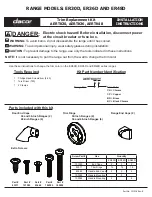
8
flame is normal and simply indicates the presence of salt in the
atmosphere (from cooking). If the flame has yellow patches,
this is not a fault (of any kind).
Cooking recommendation
Cooking pans
Suitable pans
The chart below gives the correct pan usage for each burner.
Precautions for use
The following advice is intended to help you save energy and
prevent pan damage:
Cleaning and maintenance
Cleaning
Once the appliance is cool, use a sponge to clean it with soap
and water.
After each use, clean the surface of the respective burner parts
once they have cooled down. If any residue is left (baked-on
food, drops of grease etc.), however little, it will become stuck
to the surface and more difficult to remove later. The holes and
grooves must be clean for the flame to ignite properly.
The movement of some pans may leave metal residue on the
pan supports.
Clean the burners and pan supports using soapy water and
scrub with a non-wire brush.
If the pan supports are fitted with rubber rests, ensure that
these are also cleaned. The rests may come loose and the pan
support may scratch the hob.
Always dry the burners and pan supports completely. Water
droplets or damp patches on the hob at the start of cooking
may damage the enamel.
After cleaning and drying the burners, make sure the burner
caps are correctly positioned on the diffuser.
Caution!
■
Do not use steam cleaners. This could damage the hob.
■
Do not use knives, scrapers or similar implements to clean
the point where the glass meets the burner trims, the metal
frames or the glass/aluminium panels, if fitted.
Maintenance
Always clean off any liquid as soon as it is spilt. This will
prevent food remains from sticking to the hob surface and you
will save yourself any unnecessary effort.
Do not leave acidic liquids (e.g. lemon juice, vinegar, etc.) on
the hob.
Burner
Very high - High Medium
Low
Wok burner
Boiling, steam-
ing, griddling,
toasting, paellas,
Asian food (wok).
Reheating and keeping
things hot: cooked and pre-
cooked dishes
Rapid burner Escalopes,
steaks, ome-
lettes, frying
Rice, white
sauce, ragout
Steaming:
fish, vegeta-
bles
Semi-rapid
burner
Steamed pota-
toes, fresh vege-
tables, vegetable
stews, pasta
Reheating, keeping things
hot and making tasty casse-
roles
Auxiliary
burner
Cooking: casse-
roles, rice pud-
ding, caramel
Defrosting
and slow
cooking: veg-
etables, fruit
and frozen
products
Melting: but-
ter, choco-
late, jelly
Do not place anything, eg. flame
tamer, asbestos mat, between
pan and pan support as serious
damage to the appliance may
result.
Do not remove the pan support
and enclose the burner with a
wok stand as this will
concentrate and deflect heat
onto the hotplate.
Do not use large pots or heavy
weights which can bend the pan
support or deflect flame onto the
hotplate.
Burner
Minimum pan
diameter
Maximum pan
diameter
Wok burner
22 cm
-
Rapid burner
22 cm
26 cm
Semi-rapid burner
14 cm
20 cm
Auxiliary burner
12 cm
16 cm
Use pans which are the right
size for each burner.
Do not use small pans on
large burners. The flame must
not touch the sides of the pan.
Do not use damaged pans,
which do not sit evenly on the
hob. Pans may tip over.
Only use pans with a thick, flat
base.
Do not cook without using a lid
and make sure the lid is
properly fitted. This wastes
energy.
Always centre the pan over the
burner, not to one side.
Otherwise it could tip over.
Do not place large pans on the
burners near the control
knobs. These may be
damaged by the very high
temperatures.
Place the pans on the pan
supports, never directly on the
burner.
Make sure that the pan
supports and burner caps are
correctly positioned before
using the appliance.
Pans should be placed on the
hob carefully.
Do not strike the hob and do
not place excessive weight on
it.





























